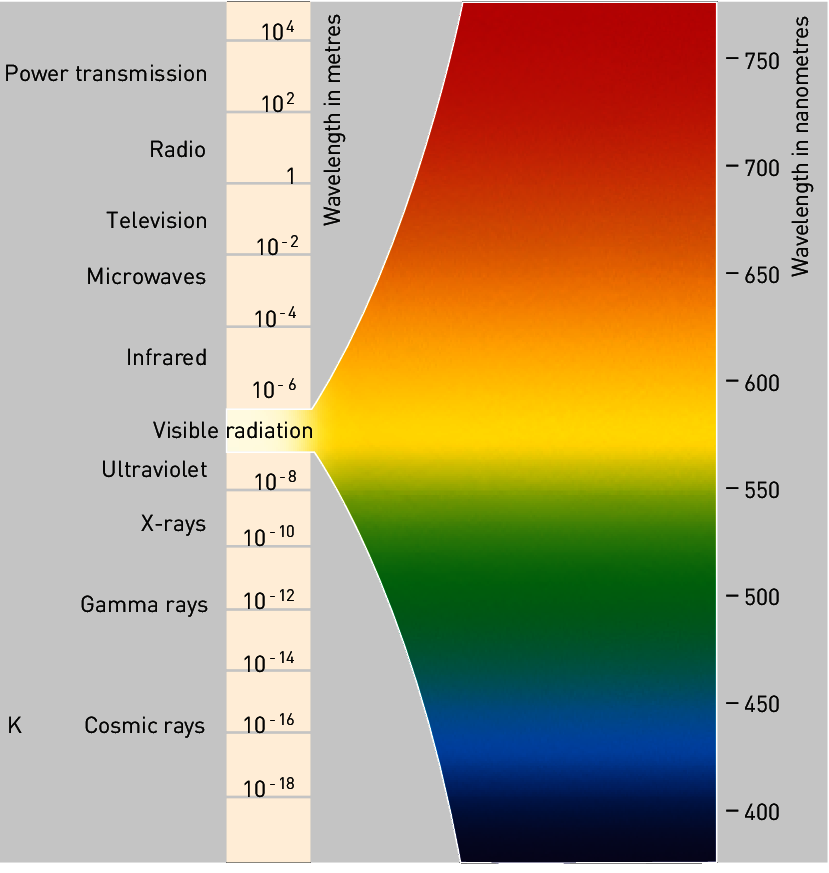High-frequency electromagnetic fields (EMF) occur in wireless information transmission such as radio, television and mobile radio applications.
High frequency EMF
The effects of high-frequency EMF essentially depend on their frequency. Based on frequency/wavelength (figure), they are distinguished as follows:
Non-ionising radiation, meaning EMF with wavelengths between 1 km and 1 m (radio waves); EMF with wavelengths between 1 m and 1 mm (microwaves) as well as infrared, visible and ultraviolet radiation with wavelengths down to 100 nm (frequency range of up to 300 GHz).
Ionising radiation, meaning X- and gamma radiation with frequencies of up to 750 THz (terahertz). The second type of radiation causes extreme effects and must be avoided due to severe risks, e.g. changes in genetic make-up. High-frequency fields of this nature are subject to particular safety measures due to their damaging effects.

Figure 3.206: The spectrum of electromagnetic radiation
For non-ionising radiation starting at 100 nm, biological effects must be classified into thermal and athermal effects. In thermal effects, radiant energy is absorbed by the body and converted to heat. EMF cause eddy currents which heat up electrically conductive body tissues and prevent a penetration of the field (skin effect). The so-called penetration depth is the value where the field has dropped down to 1/e = 37 %. At a frequency of 1 GHz, it varies between 1.8 cm (muscle) and 18 cm (bone) depending on the type of body tissue. The threshold is set on the basis that thermal damage in the body must be ruled out. Absorbed energy is referred to as the SAR value (specific absorption rate) and largely depends on the frequency. Accordingly, maximum permissible thresholds also depend on frequency. Organs with low levels of heat conductivity and low degrees of perfusion (e.g. eye lens) as well as organs sensitive to temperatures are particularly affected.
EU directive 2004/40/EC of 29 April 2004 contains exposition thresholds and SAR values for electromagnetic fields in relation to frequency, more specifically:
exposition thresholds for current density (in mA/m2) for temporally fluctuating fields up to 1 Hz to prevent effects on the cardiovascular as well as central nervous systems;
exposition thresholds for current density in the frequency range between 1 Hz and 10 MHz to prevent effects on central nervous system functions;
exposition thresholds and SAR values for fields between 100 kHz and 10 GHz to prevent thermal stress on the entire body and excessive localised warming of tissue;
exposition thresholds for current density as well as SAR values for fields in the range between 100 kHz and 10 MHz to prevent excessive warming of tissue at or near the body’s surface;
an exposition threshold for the power density (in mA/m2) in fields between 10 GHz and 300 GHz to prevent excessive warming of tissue at or near the body’s surface.
The impact of thermal effects is scientifically undisputed and ranges from increased chances of developing cancer to severe deformities in offspring discovered in animal testing. Other established consequences are disruptions in metabolism, gland function and blood/immune/nervous system, cataracts and even internal burns as well as cardiac infarctions at extremely high field intensities. Athermal effects are effects which occur below the thermal effectiveness threshold. Their existence is mostly scientifically accepted at this point. The only aspect in dispute is whether or not they can cause health effects, since they can be counteracted by bodily regulation and control mechanisms. Effects often only occur within narrow amplitude and frequency ranges. A study conducted by the Institute of Social and Preventive Medicine (ISPM) at the University of Bern/Switzerland indicates that various conditions such as sleep disorders, nervousness and feelings of faintness occur significantly more often in people exposed to long-term stress by a 3 x 150 kW short-wave radio transmitter at a distance of less than 2 km than it did in people living in more distant homes.